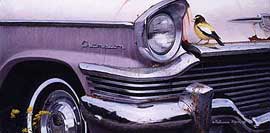
Plate 55 |
|
immobile and flighty, and inanimate and living--all invite viewers to consider the content. The painting suggests multiple themes of obsolesce and senesce, self and other, territory holding and perceived treats to territory, and avian habitat and the human footprint on it. This portrayal is testimony to the passage of time. The Canadian artist Patricia Pépin has a great appreciation for natural cycles and life spans, “Nature breaks down things all the time, through weather and microorganisms. Everything is being digested all the time, and nowhere is this more evident than on manmade things.” The invasive nature of decay is more apparent upon scrutiny of the car she found “behind a gas station in Maine, with many other vintage cars, in different stages of decrepitude, destined to be restored or salvaged for pieces.” Pépin says, “When I saw this old car in a goldenrod field I was seduced by its peeling chrome and chalky paint.”[51]
The artist also has great appreciation for placing birds in a biologically appropriate context: “I needed a yellow bird, geographically correct, to be the focal point of the painting." And the grosbeak added the perfect note for it seemed to engage in a ‘dialogue’ with the flowers, and its massive beak reminded me of the big fender of the Studebaker.” She also has,
page 3-->
|

